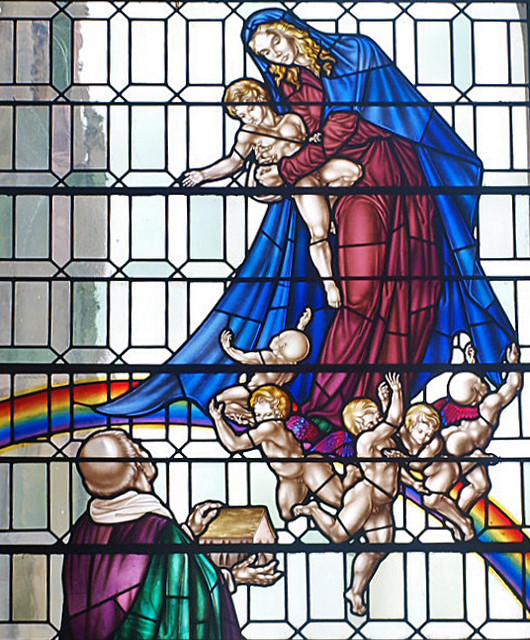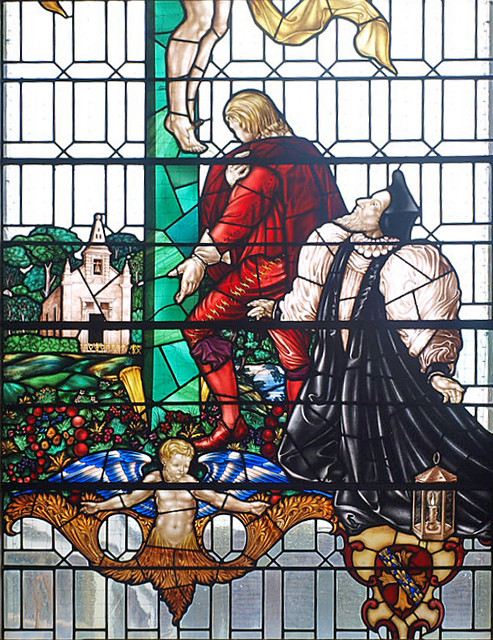The Master’s Lodge adjoins the Hall on the E. On the other side of the Hall the CHAPEL follows. It is reached by a doorway with a big shell-hood. The doorway must be older than the chapel. Its date is probably c. 1690. It must therefore have been made to give access to the old chapel. A passage leads to the entrance into the antechapel. This and the Chapel date from 1763-9. They were designed by James Burrough and carried on after his death by James Essex. The exterior is conservative for the date. With its E front clearly derived from Wren’s Pembroke Chapel and its S front with Corinthian pilasters, plain arched windows and a balustrade keeping to the height of the adjoining W front of the E range it seems more of the early than of the later C18. Inside, the antechapel is a fine design, more ambitious than any other. It is octagonal with skylighting from a glazed cupola. The detail is very chaste. In the Chapel itself the segmental vault of the ceiling and the segmental plan of the apse are both equally typical of their date (cf. Robert Adam or Dance). Noble W GALLERY and REREDOS (the painting of the Annunciation is by Giovanni Battista Cipriani, one of the founder members of the Royal Academy). The STAINED GLASS of the windows by Wailes has been destroyed, and two have been replaced by glass of Mr Hugh Easton’s in 1936. Time will show whether the change was wise.
Seen at its best from the beautiful river lawn of King’s, Clare’s walls of mellowed sandstone, topped by balustrades and pierced by handsome windows, appear to be a noble addition to King’s, though Clare is much older. It was founded as University Hall in 1326 by Richard Badew, and took the name of Clare from Lady Elizabeth de Clare, its second founder. The small quadrangle had become ruinous at the end of the Elizabethan Age, and was replaced by this splendid court. More like a palace than a college, as one admirer said of it, it took about 80 years to build, from the early days of Charles Stuart to the end of Queen Anne. It stands as a striking example of English Renaissance work. The beautiful ironwork of the gates and railings, designed by a great craftsman of Wren’s day, is a fit prelude to the fan-vaulting of the entrance; and both are a courtly introduction to the grace of a harmonious quadrangle which must have been thought a triumph by the architect and the masons too.
From the quadrangle a path leads to a charming stone bridge with three round arches under parapets, 300 years old and the best known of all the bridges of the Backs. No view of the river is complete without Thomas Grumbold’s bridge, and the scene from it where the willows overhang the river, closing in beyond so that the picture is like a dream, is. one of the favourite sights of Cambridge. Across the bridge the path continues along an elm avenue, with Warren’s gates at each end, to the new buildings of the college. Designed by Sir Giles Scott in memory of nearly 200 men of Clare who fell in the Great War, they stand on rising lawns behind great trees, a flight of steps mounting to an archway, which leads to a spacious court and frames a striking view of the great tower of the University Library.
The names of the men are written on panels in an old octagonal chapel with arcaded walls and a panelled dome. The chapel, of a fine simplicity, has its old panelling, a rich coved ceiling with floral bosses, a handsome organ resting on an imposing screen, Cipriani’s Annunciation for an altarpiece, and two windows with beautiful glass. In one Richard Badew is kneeling on a sphere, offering his University Hall and its band of scholars to the Madonna, who stands on a rainbow holding the boy Jesus, cherubs about her feet; in the other are Hugh Latimer and Nicholas Ferrar, both of this college; both kneeling by a cross, Ferrar in court dress of flowing red, Latimer in the black and white garb of a priest. In the lantern beside him is a candle, reminding us of his last brave words:
Be of good comfort, Master Ridley, and play the man, for we shall this day light such a candle in England as I trust by God’s grace shall never be put out.
The 17th century hall is a lofty and stately chamber with a magnificent ceiling, and panelled walls adorned at each end with richly carved pilasters. Among the portraits are Lady Elizabeth de Clare, Richard Love, Edward Atkinson, Peter Gunning, Charles Townshend, Hugh Latimer, Isaac Bargrave, Thomas Holles (Duke of Newcastle), Thomas Cecil (Earl of Exeter), John Tillotson, Lord Cornwallis, Josiah Hort, and Martin Folkes.
From the quadrangle a path leads to a charming stone bridge with three round arches under parapets, 300 years old and the best known of all the bridges of the Backs. No view of the river is complete without Thomas Grumbold’s bridge, and the scene from it where the willows overhang the river, closing in beyond so that the picture is like a dream, is. one of the favourite sights of Cambridge. Across the bridge the path continues along an elm avenue, with Warren’s gates at each end, to the new buildings of the college. Designed by Sir Giles Scott in memory of nearly 200 men of Clare who fell in the Great War, they stand on rising lawns behind great trees, a flight of steps mounting to an archway, which leads to a spacious court and frames a striking view of the great tower of the University Library.
The names of the men are written on panels in an old octagonal chapel with arcaded walls and a panelled dome. The chapel, of a fine simplicity, has its old panelling, a rich coved ceiling with floral bosses, a handsome organ resting on an imposing screen, Cipriani’s Annunciation for an altarpiece, and two windows with beautiful glass. In one Richard Badew is kneeling on a sphere, offering his University Hall and its band of scholars to the Madonna, who stands on a rainbow holding the boy Jesus, cherubs about her feet; in the other are Hugh Latimer and Nicholas Ferrar, both of this college; both kneeling by a cross, Ferrar in court dress of flowing red, Latimer in the black and white garb of a priest. In the lantern beside him is a candle, reminding us of his last brave words:
Be of good comfort, Master Ridley, and play the man, for we shall this day light such a candle in England as I trust by God’s grace shall never be put out.
The 17th century hall is a lofty and stately chamber with a magnificent ceiling, and panelled walls adorned at each end with richly carved pilasters. Among the portraits are Lady Elizabeth de Clare, Richard Love, Edward Atkinson, Peter Gunning, Charles Townshend, Hugh Latimer, Isaac Bargrave, Thomas Holles (Duke of Newcastle), Thomas Cecil (Earl of Exeter), John Tillotson, Lord Cornwallis, Josiah Hort, and Martin Folkes.




No comments:
Post a Comment